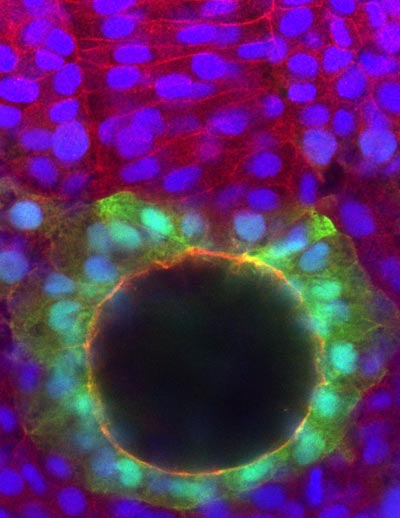December 22, 2014
Breaking the rules of symmetry
IST Austria professor Carl-Philipp Heisenberg and his group in Developmental Cell paper provide insight into the mechanisms responsible for left-right asymmetry in vertebrates

We can see asymmetry on all of our body axes: Our front is different from our back, and our head is different from our foot. But also our left is different from our right. In a paper published in Developmental Cell on 22 December 2014, Carl-Philipp Heisenberg, Professor at the Institute of Science and Technology (IST Austria), and his group provide insight into the mechanisms that lead to this left-right asymmetry.
Left-right asymmetry is seen, for example, in the placement of our heart, which is usually positioned on the left body side. In many vertebrates, this left-right asymmetry depends on an organ specialized for symmetry breaking, which exists only transiently at the end of gastrulation. In zebrafish, the organism studied by the Heisenberg group, this organ is called Kupffer’s vesicle (KV). Kupffer’s vesicle is a fluid-filled cavity that is lined by cells which each carry one cilium, a slender protrusion. These cilia beat to make the fluid in the cavity flow towards the left side. This leftward flow is essential for left-right patterning in the zebrafish. For Kupffer’s vesicle to achieve an efficient flow, the cilia in the anterior-dorsal (AD) region have to be denser than in other regions. As each cell carries only one cilium, the cells in this AD region have to be clustered together more densely than cells in the other regions. Heisenberg and his group therefore investigated the mechanisms involved in setting up this more densely packed region.
First, the researchers made cell density more similar across Kupffer’s vesicle using drugs. This led to disruptions in the left-right patterning, confirming that differences in cell density are essential for left-right asymmetry. They then analyzed the morphology of Kupffer’s vesicle and its surroundings, to see if there are any structures that could provide Kupffer’s vesicle with patterning signals. The most densely packed cells are found adjacent to the notochord, a structure that defines the embryo’s primitive axis. When the researchers induce ectopic Kupffer’s vesicles, which are not located next to a notochord, they see no region of densely packed cells in Kupffer’s vesicle. This suggests that the notochord induces the changes in the cell shape that allow cells to pack closely together in the AD region.
Finally, the authors showed that components of the extra-cellular matrix (ECM) accumulate on the notochord, close to the densely packed cells of Kupffer’s vesicle. When they remove some of these components, the cells are less densely packed. And when they create an artificial gradient of ECM components, such that there are more components on one side of Kupffer’s vesicle than on the other, the cells are packed more densely on the side with more ECM components.
Concluding, these findings suggest that the notochord modulates the ECM close to Kupffer’s vesicle. The ECM then affects cell shape and density in Kupffer’s vesicle. The authors suggest that the ECM is likely to act by changing the contractility of cells in Kupffer’s vesicle.



